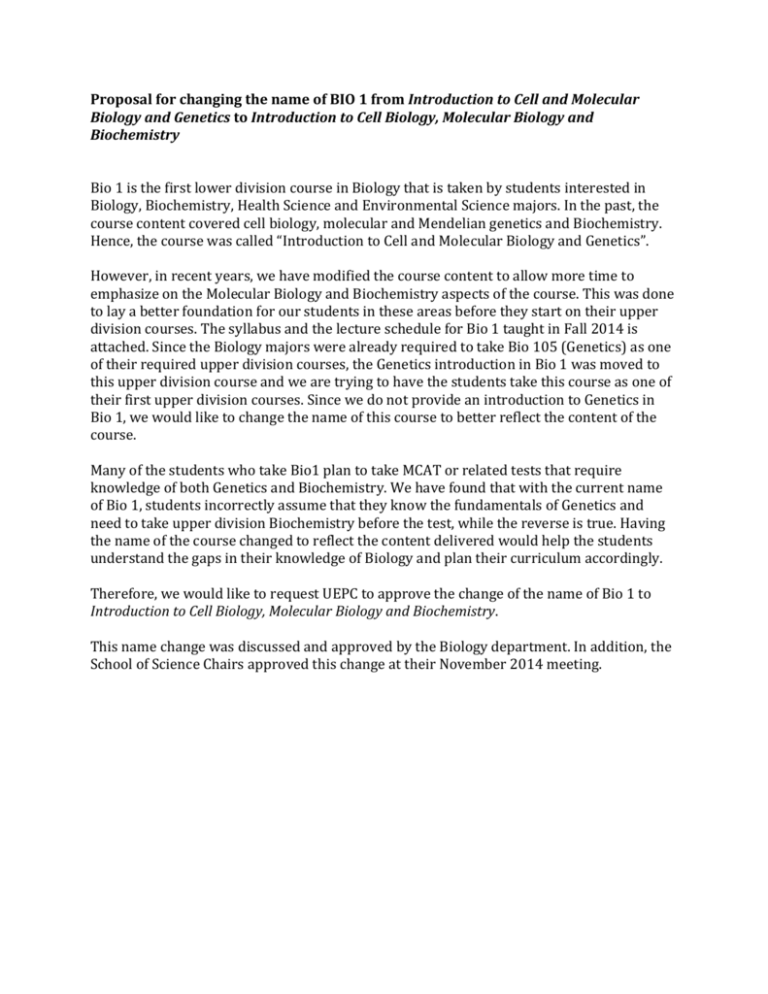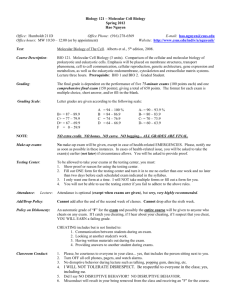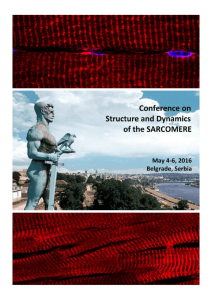Proposal for changing the name of BIO 1 from Introduction to Cell
advertisement

Proposal for changing the name of BIO 1 from Introduction to Cell and Molecular Biology and Genetics to Introduction to Cell Biology, Molecular Biology and Biochemistry Bio 1 is the first lower division course in Biology that is taken by students interested in Biology, Biochemistry, Health Science and Environmental Science majors. In the past, the course content covered cell biology, molecular and Mendelian genetics and Biochemistry. Hence, the course was called “Introduction to Cell and Molecular Biology and Genetics”. However, in recent years, we have modified the course content to allow more time to emphasize on the Molecular Biology and Biochemistry aspects of the course. This was done to lay a better foundation for our students in these areas before they start on their upper division courses. The syllabus and the lecture schedule for Bio 1 taught in Fall 2014 is attached. Since the Biology majors were already required to take Bio 105 (Genetics) as one of their required upper division courses, the Genetics introduction in Bio 1 was moved to this upper division course and we are trying to have the students take this course as one of their first upper division courses. Since we do not provide an introduction to Genetics in Bio 1, we would like to change the name of this course to better reflect the content of the course. Many of the students who take Bio1 plan to take MCAT or related tests that require knowledge of both Genetics and Biochemistry. We have found that with the current name of Bio 1, students incorrectly assume that they know the fundamentals of Genetics and need to take upper division Biochemistry before the test, while the reverse is true. Having the name of the course changed to reflect the content delivered would help the students understand the gaps in their knowledge of Biology and plan their curriculum accordingly. Therefore, we would like to request UEPC to approve the change of the name of Bio 1 to Introduction to Cell Biology, Molecular Biology and Biochemistry. This name change was discussed and approved by the Biology department. In addition, the School of Science Chairs approved this change at their November 2014 meeting. BIOL 001 (Cell and Molecular Biology and Genetics) Introductory Biology for Majors Course Syllabus Garrison Fall 2014 BIOL 001 Cell and Molecular Biology and Genetics Course Syllabus Lecture: BIOL 001 MWF 11:45 am – 12:50 pm SICH 101 Lab: Various sections and instructors Instructor: Keith E. Garrison, Ph.D. Office hours: TBA or by appointment Office phone: 631-4174 Email: keg4@stmarys-ca.edu Textbook Campbell, Reece Biology 10th ed. Publisher: Pearson/Benjamin Cummings # ISBN-13: 9780321775658 Lab Manual Distributed in your lab section Course summary Biology 1 will lead us to an understanding of the biochemical basis of critical functions of living cells, such as photosynthesis, glycolysis and fermentation/cellular respiration. The course is guided by the principle of the genetic basis of cell structure and function. This course will begin to teach you to think like a biologist. You will integrate your knowledge of chemistry into an understanding of biological systems. You will also begin to consider the complexity of living organisms with the vast array of reactions and processes occurring at every moment in living cells. The laboratory is a required part of this course. There is an additional course fee for the lab. This fee covers the cost of laboratory materials that you will use during this course. There is a large amount of material for you to learn in this course. For some of the material, there is no other way to learn it aside from memorization. It is really important to keep current with the material in the course because later concepts build on an understanding of the basic concepts and ideas taught at the beginning of the course. If you do not understand a concept, I STRONGLY urge BIOL 001 (Cell and Molecular Biology and Genetics) Introductory Biology for Majors Course Syllabus Garrison Fall 2014 you to come to see me in office hours or by appointment. The best students will make office hours a regular part of their weekly course schedule. Do NOT wait until just before an exam because there is little that I can do to help at the last minute, and you will find that my time is in high demand by many other students. Student Disability Services Statement Student Disability Services: Reasonable and appropriate accommodations for individuals with qualifying disabilities are extended through the office of Student Disability Services. Students with disabilities are encouraged to contact the Student Disability Services office at (925) 631-4358 to set up a confidential appointment to discuss accommodation guidelines and available services. Additional information may be found at the following address on the Saint Mary’s website: http://www.stmarys-ca.edu/sds Student Responsibilities It is vital that you meet your student responsibilities to get the most out of this course. I expect students to: • Attend every lecture and keep up with the material. • If you have a question, ask! Others are probably wondering the same thing. • Attend office hours to address any questions that we do not or cannot cover in lecture. • Clarify difficult or confusing material as we cover it in class, not just before an exam. • Study regularly for this course, not only before exams. This will help you take advantage of office hours. It will also make the amount of material in the course more manageable. • Be an active participant in lecture. • Keep up with the reading in the textbook. • Respect the learning environment: absolutely no cell phone calls, text messaging, or internet use during lecture. Keep cell phones on silent and in your backpacks during class. • Respect the opinions and experiences that others choose to share in class. Office Hours I put office hours here in the syllabus because it is a joint responsibility for both of us. I set up office hours at a time that works for the largest number of students possible and also works with my schedule. This is time that I set aside for you. If you have questions that are not addressed in lecture, you need to make time to come to office hours. If I happen not to be in my office, look for me in the lab or elsewhere in the building. If you would like to meet at another time, please email to make an appointment. To help facilitate drop in office hours, please follow my BIOL 001 (Cell and Molecular Biology and Genetics) Introductory Biology for Majors Course Syllabus Garrison Fall 2014 Twitter feed @ProfGarrisonSMC. I will tweet when I am available in my office outside regular office hours for drop in questions. Instructor Responsibilites I see the following as important factors in my role to make BIO 001 a successful course: • Present clear and focused lectures on the course topics. • Incorporate relevant current and background research studies into the course. • Be available during office hours to expand on course material for students. Learning Objectives Upon completion of this course, students will be able to: • Describe the basic molecules required for cells to function. • List the enzymes of DNA replication and repair and describe their functions within the nucleus of the cells. • List the organelles found within cells and describe their structure and functions. • List the enzymes involved in transcription and translation in the cell and describe their function. • Compare and contrast the processes of transcription and translation within the cell. • Describe and compare the mechanisms for the control of gene expression in prokaryotes and eukaryotes. • Describe the processes involved in glucose utilization and list the enzymes and organelles involved. • Compare the processes of glucose utilization in the presence or absence of oxygen. • Describe the processes involved in photosynthesis and list the enzymes and organelles involved. • Compare the processes of photosynthesis that occur in the presence or absence of sunlight. • Describe the processes by which cells communicate with each other in a multi-cellular organism. • List and describe the phases of cell division. • Compare and contrast the processes of mitosis and meiosis. • Compare and contrast the inheritance of single traits and multiple traits within a genetic cross. The responsibility for meeting these learning objectives ultimately rests with you. You should be able to meet them through attendance in lecture and lab, BIOL 001 (Cell and Molecular Biology and Genetics) Introductory Biology for Majors Course Syllabus Garrison Fall 2014 completing all course assignments, and preparing for exams. I am here to help and guide you in meeting these objectives. Foundations for Success Below is a list of techniques that successful students have used in this course in the past. Using these techniques is not a guarantee of success, but they should help you perform at your best in this course: 1. Take good notes in class. This does not mean record every word I say. It does mean that you should make sure that you have adequate detail about the important concepts that we cover to help you learn them. 2. Read actively and keep current with the reading. Read with a pencil in your hand to take notes on the reading and identify important or interesting points. 3. Recopy your notes weekly. This will help you to synthesize your lecture notes with your reading. You should also download the lecture slides to complement your notes. All of this will also help you identify any areas that you do not fully understand so that you can clarify them in office hours. 4. Make flashcards to learn the definitions of new terms. Use them on an ongoing basis throughout the course, not just right before exams. We learn a lot of new terms in this course and then begin to use the terms right away. 5. Talk about biology with other students in the course. Try to talk through processes like DNA replication or glycolysis. This will help you in a number of ways. By discussing the material with other students, you will discover aspects of biological processes that you misunderstood or overlooked. You will begin to use new biological terms properly. You will have practice synthesizing complex ideas and integrating them into a coherent picture of how the living systems function. Exams and Grading There will be three midterm exams during lecture and a comprehensive final exam for this course. On midterm exam days, there will be no lecture. Exams will consist of a combination of multiple choice and short answer/essay questions. The dates for the midterms are shown on the course schedule. Do not plan work hours or travel in conflict with an exam date and time. There will be no make-up exams for this course. If you must miss an exam due to illness or other emergency, you must notify me before the exam. Any unexcused absence from any exam will result in a grade of zero for that exam. Exams are available for review in my office following the return of your Scantron forms in lecture. I advise that you review each exam soon after each midterm exam date. It will help you to learn better from your mistakes on the exam. BIOL 001 (Cell and Molecular Biology and Genetics) Introductory Biology for Majors Course Syllabus Garrison Fall 2014 Waiting until just before the final exam to review your midterms means more material to review and learn all at once. Copying down questions from the exam, photographing the exam or otherwise reproducing questions is not allowed and will be considered a violation of the honor code. Your grade for the course will be based upon the following: Graded assignments and quizzes 5% Exams 65% Lab Grade 30% You must earn a passing grade in BOTH lecture and lab in order to pass the course. This is my grading scale, subject to adjustment based on the top and the mean scores in the course section: A 100-94% A- 93-90% B+ 89-87% B 86-83% B- 82-80% C+ 79-77% C 76-73% C- 72-70% D+ 69-67% D 66-63% D- 62-60% F < 60% Grade distributions are not determined until the end of the semester using the total points for the course. However, we encourage you to estimate your grade for each exam using the top and mean exam scores (that we will report to you after the exam) for comparison. If you do not receive a passing grade on an exam, we strongly encourage you to start attending office hours regularly and to make an appointment to discuss new study strategies and approaches to learning the course material. Students must earn a C- or better in BIOL 001 to progress to BIOL 002. Academic Honesty Policy Academic honesty is extremely important in the sciences. All scientists must accurately report data that are the verified results of their own experimentation. Without these strict standards, our system of scientific inquiry would unravel. This course operates under the premise of the academic honor code, including the expectation that you will work to uphold high standards of integrity. This applies to all assignments in the course, including lab reports and exams. I consider photographing any exam materials to be a reportable violation of the honor code. I am available to discuss issues of academic integrity and any questions you might have about the relationship between the policy and this course. To understand the academic honor code in full, please see the most recent Student Handbook. Disclaimer: The syllabus and course schedule are subject to change during the semester. Notice of any changes will be announced in class and/or posted on the Blackboard site for the course. An updated syllabus or schedule will also be posted. BIO 001 Dr. Keith Garrison Dr. Sonya Schuh-Huerta FALL 2014 Dr. James Pesavento Introduction to Cell, Molecular Biology and Genetics # 1 2 3 Day M W F M Date 1 September 3 September 5 September 8 September 4 5 6 7 8 W F M W F 9 10 11 12 13 14 15 16 17 18 19 20 21 Reading 10 September 12 September 15 September 17 September 19 September Lecture Topic Holiday Introduction Molecules of Life Polymers – Carbohydrates, Lipids-Chem quiz Proteins Enzymes and catalysis Enzyme Regulation DNA, RNA, Chromosomes Overview of a cell M W F M W F 22 September 24 September 26 September 29 September 1 October 3 October Tour of cell Cytoskeleton and Extracellular matrix Exam 1 Membrane structure Membrane Transport Membrane potential 6.1 to 6.5 6.6 – 6.7 M W F M W F M W F M 6 October 8 October 10 October 13 October 15 October 17 October 20 October 22 October 24 October 27 October Cell communication Cell Signal transduction Cell cycle and Mitosis- Mitosis quiz Cell cycle regulation, cancer Cell death Exam 2 Meiosis Meiosis and fertilization Holiday DNA replication 1 2, 3, 4 5.1 to 5.3 5.4 8.4 8.5 5.5, 16.3 6.1 to 6.5 7.1 – 7.2 7.3 – 7.5 7.3 – 7.5, 48.2, 48.3 11.1 – 11.4 11.1 – 11.4 12.1, 12.2 12.3, 18.5 11.5 13 13 16 BIO 001 Dr. Keith Garrison Dr. Sonya Schuh-Huerta FALL 2014 Dr. James Pesavento Introduction to Cell, Molecular Biology and Genetics 22 23 24 25 26 27 28 29 30 31 32 33 34 35 W F M W F M W F M W F M W F M W F 29 October 31 October 3 November 5 November 7 November 10 November 12 November 14 November 17 November 19 November 21 November 24 November 26 November 28 November 1 December 3 December 5 December 9-12 December DNA repair Transcription RNA processing Protein Synthesis, folding and transport Mutation Control of gene expression in prokaryotes Control of gene expression in Eukaryotes Exam 3 Metabolism: Bioenergetics and ATP Redox Glycolysis Fermentation Thanksgiving Holiday Thanksgiving Holiday Tricarboxylic acid cycle Chemiosmosis Photosynthesis Final Exam (Comprehensive final) 16 17.1, 17.2 17.3 17.4 17.5 18.1 18.2 – 18.4 8.1- 8.3 9.1 9.2 9.5-9.6 9.3 9.4 10.1 - 10.4






